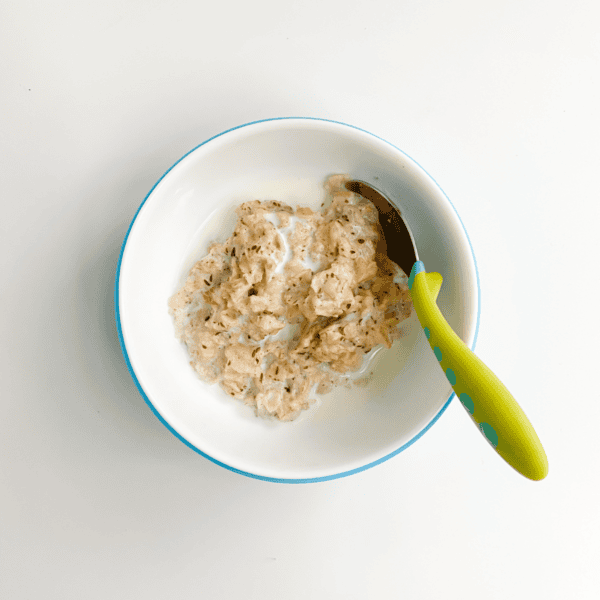What should babies feed themselves?
Feb 21, 2021, Updated Nov 08, 2023
This post contains affiliate links. Please see our disclosure policy.
This post is sponsored by Stonyfield Organic; all opinions are my own.
Are you a mess hater?
I am. I honestly always tried to feed my first baby, Teddy, outdoors because I hated the huge mess it created. I had a whole system down- I’d put down an old bath towel, bring the food out, then bring Teddy out. Oh but first I’d strip him! I didn’t want to stain his clothes. Then I’d sit on my hands so that I would keep myself from wiping him down constantly.
Even though it was NOT my favorite, the more I learned about sensory development, the more I realized that mess, especially with food, is a necessary part of babies learning about food and their environment.
And now as a dietitian who works with babies and toddlers, one of the things I always encourage parents is to allow their babies to self-feed, which is M-E-S-S-Y.
And it can be a little nerve-wracking to get started with, too. When are they ready? What can they feed themselves? How do you serve it? I’ll be answering all those questions, plus giving you my top easy (and healthy) ideas for baby to self-feed.
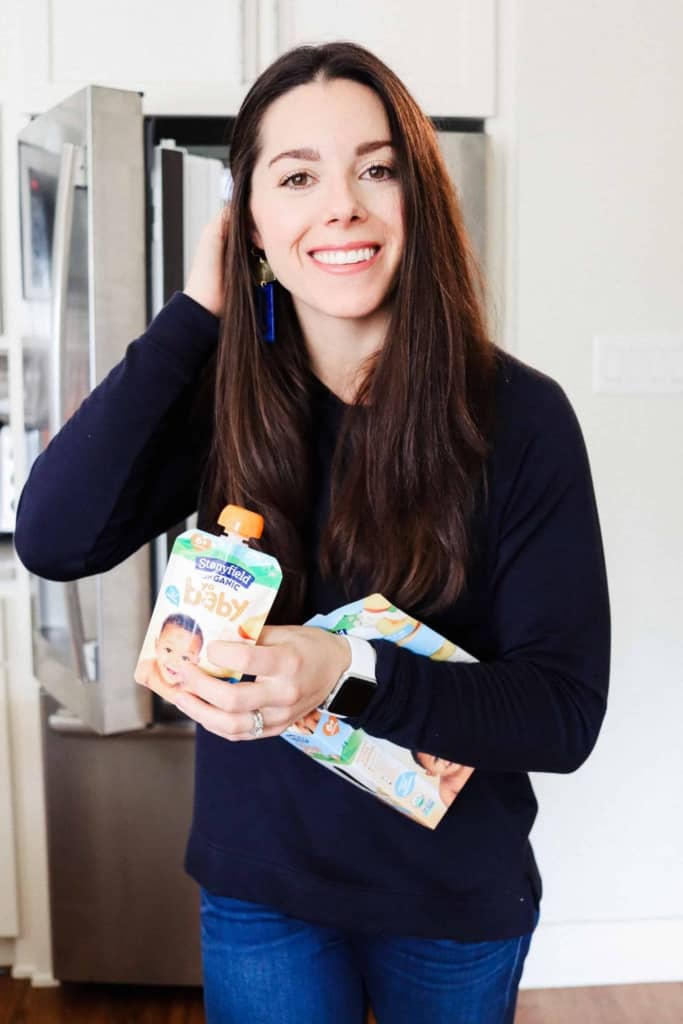
When are babies ready to self-feed?
There’s no one age that is right for all babies. It depends on their own development, and their personality, too! Some babies show interest in feeding themselves right at 6 months; others are slower to gain interest and it’s closer to 8 or 9 months.
Neither way is wrong.
My son was much slower to come around to feeding himself, while my daughter was eager right when she started solids.
I encourage you to provide opportunities for them to try it, but there’s no need to force it before they are ready.
Here are the signs of readiness and independence you’ll want to look for:
- Reaching for food or the spoon when you’re feeding them
- Trying to grab food off your plate
- The ability to bring objects to their mouth (like toys)
- The ability to sit on their own or with minimal assistance
It’s honestly a nice break for you when they start doing more self-feeding. You can actually sit and eat yourself when you don’t have to focus on feeding them! Or, multitask and fold some laundry, because, mom life.
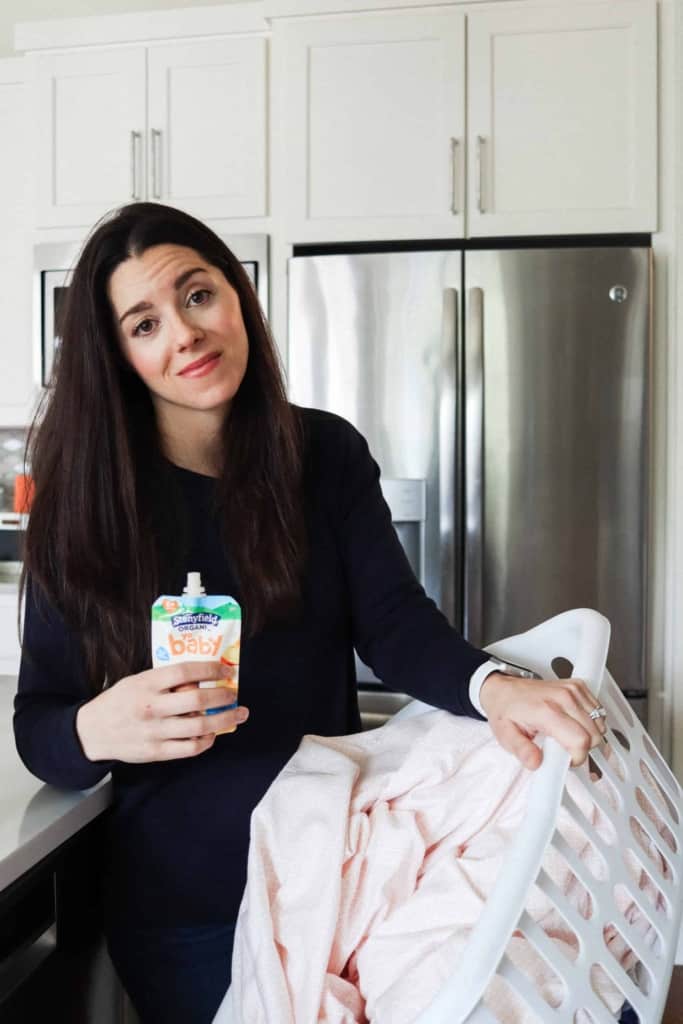
They may only be interested in playing with the food at first, and that’s okay too. They are still learning by touching and smearing food around. It is a step in the right direction towards feeding themselves…even though it can feel like they are just using the food as paint and their body as the canvas.
What can babies feed themselves?
In general, avoid anything hard, crunchy, sticky, or chewy. Choose foods that are pureed or very soft. To test for softness – see if you can smush the food between your fingers easily, or smush it with your tongue to the roof of your mouth.
You don’t have to stick to just fruits and veggies, either! I love introducing babies to a variety of foods early on to start getting them more diverse nutrition.
Yogurt is one of my favorite foods for baby, and I have a trick to make it less messy to self-feed.
Well, I’m sure you’ve already discovered the convenience of pouches and how much less messy they are. But I hear so many parents tell me they aren’t sure how to give yogurt to a self-feeding baby without them just painting their face and body with it. So, here’s the solution! Serve it in a pouch when you need to cut out the mess.
Stonyfield YoBaby pouches are made with organic whole milk, and contain real fruit, live & active cultures, vitamin D, calcium, protein and prebiotics. Yogurt is a great food for baby – and it’s safe for them to eat as soon as they start solids.
You might have heard at some point that you need to wait on dairy, but that only applies to cow’s milk as a beverage. Yogurt and cheese are safe to introduce at 6 months old.
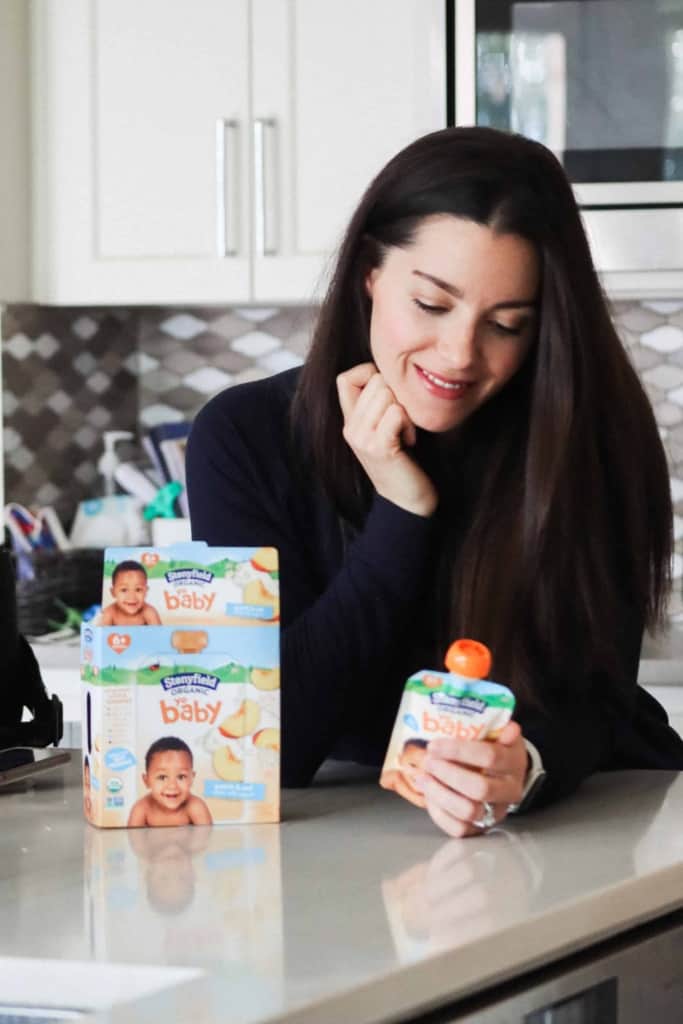
I love that yogurt contains live and active cultures. There aren’t many foods that contain these beneficial bacteria which can be good for gut health.
There is a small amount of sugar in these pouches, which I do try to limit for babies, but I wouldn’t worry about it here. It has about the same amount as you’d find in a slice of bread. It’s most important to avoid foods that are highly sweetened like cake, candy, and cookies for babies.
Easy & convenient foods to self-feed for 6 to 9 month olds:
- Stonyfield YoBaby pouch (this is the peach & oat flavor)
- Banana slice coated in ground flaxseed
- Orange wedges with a thin layer of almond butter
- Steamed cauliflower florets tossed in avocado oil
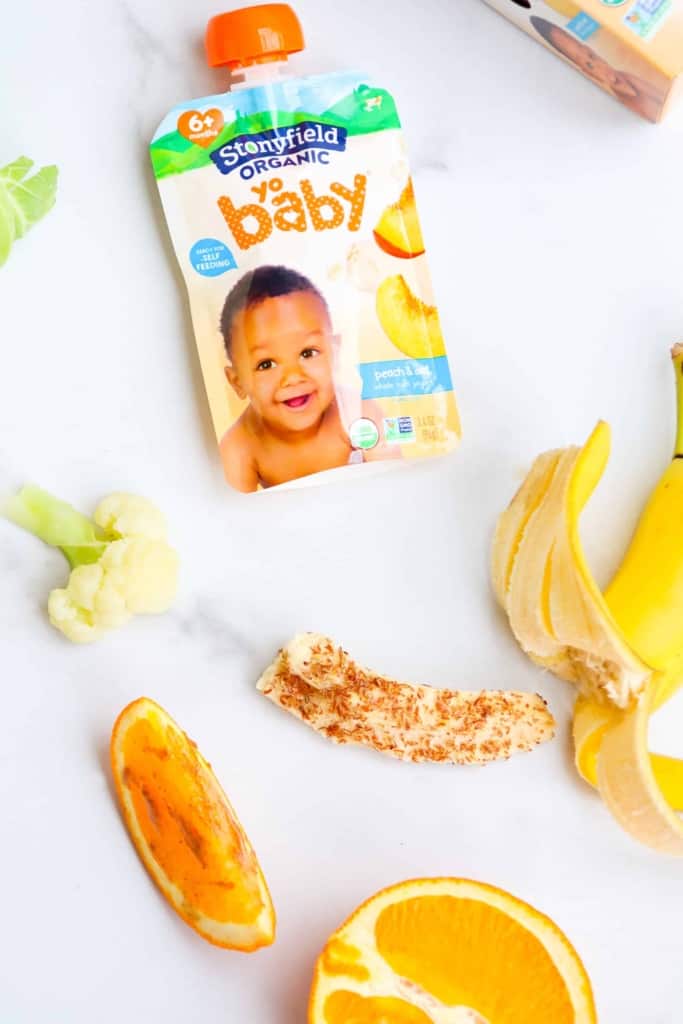
Why I love these options:
Combining fruits and veggies with fats is beneficial for babies. Here’s why:
- It’s more filling when you add a fat, so they will be more satisfied after their meal
- Babies have high energy needs (they TRIPLE their bodyweight in their first year of life!) and need lots of calories to support that growth. They can only fit so much in their tummy at one time though, so fat adds calories to the limited amount they can consume, which can help support their growth.
- In my private practice, it’s very common for me to see babies and toddlers who have trouble gaining enough weight eating diets that are relatively low in fat. It’s often the missing puzzle piece when I analyze their diet!
- Fat helps the body absorb vitamins A, D, E, and K (they are fat-soluble vitamins). So without fat, they aren’t getting the full benefits of the vitamins they are eating.
- Fat is needed for neurological development and brain function. Do not be afraid of fat.

- Stonyfield YoBaby pouch
- It doesn’t get easier than this! If you’re hesitant to dive into the world of finger foods, a pouch is a good introduction to self-feeding by allowing them to hold onto the pouch themselves. You know that the smooth texture is something they are used to. And the thing I love about these pouches in particular is that they pack in more nutrition than the typical fruit/veggie pouches. These have fat and protein, essential nutrients for your little one, that will also keep them more satisfied.
- Banana slice coated in ground flaxseed
- Bananas are one of the most affordable fruits there are! They have vitamins B6 and C, plus fiber and potassium. Coating the banana in ground flaxseed has a dual purpose. It adds omega-3 fats and makes it easier for baby to hold.
- My favorite way to prepare bananas for babies is this: peel the banana and halve it. Then, push your thumb into the middle to separate it into 3 “fingers.” It’s very easy and will be less slippery than if you slice it lengthwise with a knife.
- Orange wedges with a thin layer of almond butter
- Oranges can be quite slippery, but if you leave the peel on and cut it into wedges, baby will have an easier time grasping onto it. Make sure to cut away the white membrane so it’s easy for them to suck on. Add smooth, unsalted almond butter or peanut butter in a thin layer for that fat boost!
- Steamed cauliflower florets tossed in avocado oil
- Cauliflower and broccoli are good ones for babies because the stalk acts like a handle that fits nicely in their palm. Steam it until soft, and then drizzle on avocado or olive oil for some fat. Steaming retains more nutrients than boiling, so I generally recommend steaming or roasting veggies over boiling them. You can even do a steam-roast — where you wrap the sliced veggies in foil before roasting them. They don’t get crispy like regular roasted veggies, so it’s easier for baby to chew. I like to do this when I’m roasting veggies for the adults, so that I don’t have to do something totally separate for baby.
How to steam-roast veggies for a 6 to 9 month old:
- Preheat oven to 400 degrees F
- Slice vegetables into sticks (about the width of 2 adult fingers)
- Toss veggies with avocado oil to fully coat
- Optional: stir in spices; some suggestions are (not all together, I’d pick one or two):
- Garlic powder
- Onion powder
- Cinnamon
- Paprika
- Turmeric
- Curry powder
- Add to sheet of heavy duty aluminum foil, and fold up so it’s fully closed
- Roast for 30-45 minutes or until soft
- Let cool and serve
Note: when baby can use their pincer grasp (like they could pick up a crumb with their thumb and forefinger, usually around 9 months), then cut foods into small bite-sized pieces, like the size of a chickpea.
Want some more ideas? Here are some other foods that both my kids fed themselves as babies:
- Steam roasted carrot wedges tossed in peanut butter and cinnamon
- Avocado slices tossed in ground chia seeds
- Spinach omelet strips
- Ricotta cheese spread on lightly toasted sourdough toast strips
- Roasted salmon with olive oil and lemon
- Shrimp sauteed with garlic and oil (remove tail and slice shrimp lengthwise)
You might notice that I have included some bold flavors, like lemon and garlic. Babies are great flavor explorers, so don’t be afraid to experiment!
